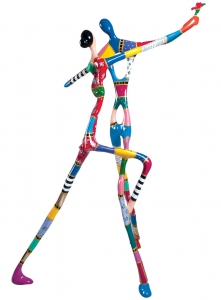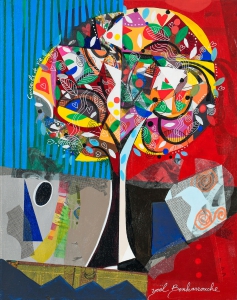Abstract art is still a relatively new but well-established style of modern and contemporary art. Abstraction in artwork is a departure from reality or an attempt to document a scene or object in art. Read on to learn more about the inspiration, origins, and purpose of abstract art.

What Is Abstract Art?
Updated: July 24 2025
What Is the Definition of Abstract Art?
There is not a single definition behind abstract art. A viewer doesn’t need to “get” an artwork or try to figure out what it means. Abstract art aims to evoke feelings that can be interpreted differently by each viewer.

There is not necessarily a solid meaning, narrative, or singular explanation for what an abstract painting aims to convey. The artist themselves may not ever verbalize the “meaning” of abstract artwork. Instead, they use their freedom of expression and trust their intuition to create artwork that provides different experiences to each individual.

Abstract art is one of the core styles of art produced in modern history. It is nonobjective art that does not aim to represent an everyday external reality. Instead of using recognizable natural forms, abstract art uses shapes, forms, colors, and textures. Abstraction describes the distancing of an idea from objective references.
What Is the Purpose of Abstract Art?
Many people do not understand precisely what abstract art is or what purpose it serves. Abstract art does not describe scenes or narratives like the art that came before it. It does not create a visual record of an event, person, or scene like figurative art or photography.

To understand abstract art, you will need an open mind and some capacity for imagination. It’s important to realize that creating and viewing abstract art is very personal.
Abstraction allows artists to visualize intangible emotions onto a canvas. It is not intended to be technically correct or convey an object to an audience. Instead, the purpose of abstract art is to convey an artist’s self-expression.
The purpose of abstract art and or art, in general, is a long-standing cultural debate. Many would argue that art does not need a purpose; it simply exists.
What Is the Opposite of Abstract Art?
The opposite of abstract is naturalistic, realistic art. The polar opposite of non-figurative abstract artwork would be the hyper-realism style of artwork or documentary photography.
What Is Semi-abstract Art?
Varying levels of semi-abstraction were observed in Impressionist artwork through the Fauvism, Cubism, and Orphism movements. These early modern art movements created artworks where the subject remained somewhat recognizable. However, the forms in semi-abstract works are highly stylized or distorted.

As artistic styles continued to develop into the 20th century and evolve, artists moved further and further away from realism. Eventually, the German and American Expressionists moved away from semi-abstraction. These abstract expressionists defined a completely nonfigurative abstract style.
What Is an Abstraction in Art?
Abstract art uses the visual languages of shape, form, color, and line. Using these languages, abstract artists create compositions that exist independently from visual references in the world. Abstract art is considered a modern or contemporary style, and despite being over a century old, it is still relatively new.

Abstraction developed at the turn of the 20th century. The origins of Abstraction are traced to other significant turn-of-the-century movements, Cubism, Impressionism, Post-Impressionism.
These movements helped paved the way for Abstraction by helping to realize and introduce the idea that artworks could be non-representative.
What Are Examples of Abstract Art?
Abstraction emerged at the turn of the 20th century, starting gradually as modern artists started incorporating dreams, symbolism, and personal iconography into their artwork. Over time some artists moved into complete Abstraction known as “nonfigurative” art.
What Is an Abstract Painting in Art?
Examples of nonfigurative abstract paintings can look completely different. One such example is the works of Jackson Pollock and Piet Mondrian. The abstract expressionist Pollock pioneered the “Paint Splatter, Drip, and Splash” technique.
This method involved applying paint to canvases through seemingly random drips and splashes. On the other hand, Mondrian creates comparatively controlled and orderly artworks using straight lines and geometry known as the “Block Color” style of Abstraction.
What Are the Different Types of Abstract Art?
There are many styles of abstract art, and the evolution of abstract art can be seen across many of the most important art movements of the 20th century.
What Are the Six Elements of Abstract Art?
The Six Abstract Art Basic Elements Are:
line.
color.
texture.
shape.
form.
value.
How an artist uses and combines these elements will define the characteristics of their artistic style.
Abstract Art Styles
Colour-related or Light-related Abstract Art

Much of the impressionists and modern artwork of the late 19th century falls into this category of semi-abstraction. This type of work uses swirls of pigment to convey colors and light to detach the subject of the art from reality.
Examples: Claude Monet, Joseph Mallord, William Turner
Cubism
Cubism was one of the earliest forms of modern Abstraction. It often still takes some inspiration from an actual scene or object but completely reinterprets it. Loosely identifiable subjects are painted in new ways, so they appear fragmented or geometrical.
Examples: Georges Braque , Pablo Picasso, Wassily Kandinsky, Yoel Benharrouche.
Gestural Abstract Art or Abstract Expressionism
The American abstract expressionists pioneered the gestural abstract style in the 1940s and 1950s. It focuses on the gestural use of color and texture often conveyed through non-conventional painting techniques such as dripping and splashing.
Examples: Jackson Pollock, Lee Krasner, Robert Motherwell, Calman Shemi.
Geometric Abstraction
Geometric abstraction uses blocks of color to create artworks that are colorful and graphic-inspired. It focuses on blocks of color and the use of geometry to create precise shapes.
Examples: Piet Mondrian, Theo Van Doesburg.
Emotional or Intuitional Abstract Art
This style can also use block colors like geometric abstraction. However, Geometric abstraction is almost mathematical and anti-nature. Intuitional Abstraction takes inspiration from nature but conveys it in a non-representational way.
Examples: Mark Rothko, Jean Arp, Barbara Hepworth.
Marbling
Marbling predated many other abstract art movements and is perhaps the first example of abstract art. It focuses on the mingling and mixing of color and does not attempt to portray reality.
Examples: Suminagashi, ancient Japanese marbling.
Line Art
As the name suggests, line art uses abstract lines and shapes to create drawings or paintings. Line art often has a surrealist subject matter and has a graphic feel.
Examples: Joan Miró, Wassily Kandinsky.
Curvilinear Abstract Art
Curvilinear abstraction is an ancient abstract style of art strongly associated with Celtic Art and Islamic art. It conveys abstract motifs such as knots of spirals.
Minimalist Abstract Art

Minimalist abstract art strips an artwork “back-to-basics.” It removes any external references and associations and usually takes a geometrical form. This minimalist abstract style can be seen in paintings but is also commonly seen in modern sculptures.
Examples: Sol LeWitt, Carl Andre.
Famous Abstract Artworks
There are countless famous abstract artworks from talented artists. Some of the most well-known abstract paintings come from innovators of the style.
Some of the best known abstract artworks include:
Composition X by Wassily Kandinsky
Composition II in Red, Blue, and Yellow, Piet Mondrian
White Center (Yellow, Pink, and Lavender on Rose) by Mark Rothko
Abstract Painting 599 by Gerhard Richter
Elegy to the Spanish Republic by Robert Motherwell
Juin-Octobre 1985 by Zao Wou-Ki
Autumn, May 1 by Chu Teh-Chun
Small Flies and Other Wings by Christine Ay Tjoe
Altarpiece nº1-3 by Hilma Af Klint
Convergence, Jackson Pollock
Well-known Abstract Artists
When abstract art burst onto the modern art scene, it was daring and shocking. The newness of the style naturally made abstract artists well-known as groundbreakers and revolutionaries.
Many of the most famous artists in the world were amongst the first wave of pioneering artists painting abstract works. Some, like Pablo Picasso, created artworks during multiple art movements, moving gradually from cubism to surrealism and then into Abstraction.
Artists who followed in subsequent decades, such as the American expressionists, took Abstraction a step further.
Some of the most well-known abstract artists include:
Wassily Kandinsky
Piet Mondrian
Helen Frankenthaler
Mark Rothko
Jackson Pollock
Sonia Delaunay
Willem de Kooning
Joan Miro
Lee Krasner
Paul Klee
What Is Abstract Expressionism Art?
Abstract expressionism was an art movement that flourished in the 1940s and 1950s. The style is categorized by gestural paint strokes or splashes. There were two primary schools of this style, the German abstract expressionists and the American abstract expressionists.
Before world war two, Europe was the center of the art world. But American abstract expressionists like Jackson Pollock helped American art and the New York art scene achieve international influence.
What Makes Abstract Art Good?

What makes abstract art good is subjective. Authenticity can be a way to judge abstract work. Much of the value of abstract work comes from
its ability to convey an authentic directness and immediacy of expression.
Abstract art is a popular choice for both private art collectors, individuals, and corporations. Abstract art can work well with modern interior design when displayed and enjoyed at home.
RELATED ARTICLES

EDEN
Updated: December 17, 2025Inside the Minds of EDEN Art Collectors
The Collectors Behind the Canvas offers an intimate look into the lives of EDEN collectors around the world. From Abu Dhabi to Dubai, discover how Dan and Nadia Feldman and Yann and Lana Biojau live surrounded by color, creativity, and meaning—revealing ...

EDEN
Updated: December 17, 2025How to Buy Art from EDEN
How to Buy Art from EDEN is your step-by-step guide to collecting art with confidence and joy. From discovering artists online to receiving personalized consultation and seamless delivery, EDEN transforms buying art into a meaningful, guided experience ...

EDEN
Updated: October 14, 2025EDEN Gallery Madison – A Chapter Closed, A Spirit That Lives On
EDEN Art Gallery Madison opened in 2009 at 437 Madison Avenue, NYC, and remained active until 2025. Although EDEN Madison closed, its influence continues through our larger galleries in SoHo and on Fifth Avenue. The EDEN Madison story is one of growth, ...
Join Our
Stay updated with the latest from the EDEN House of Art—be the first to discover new events, collections, and more!
